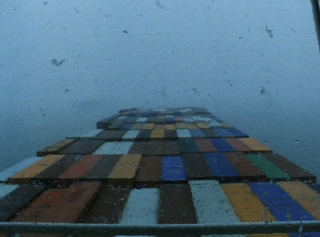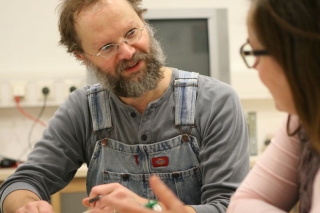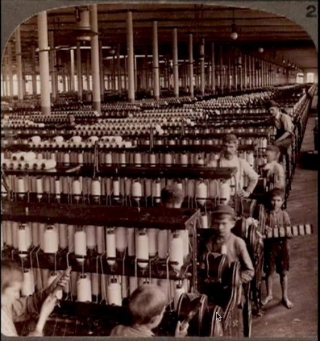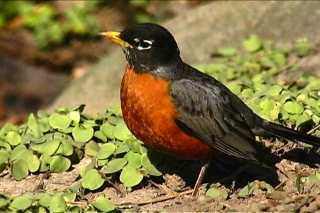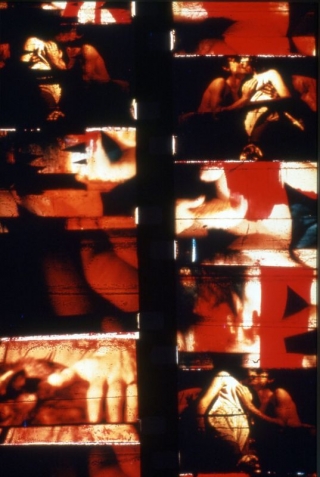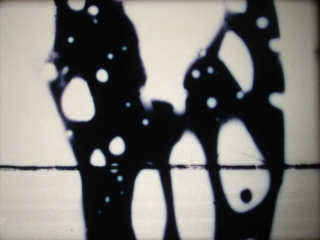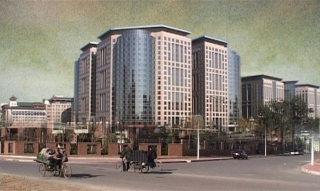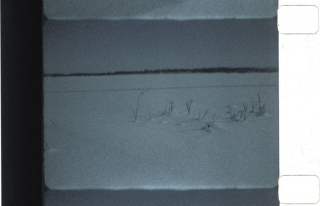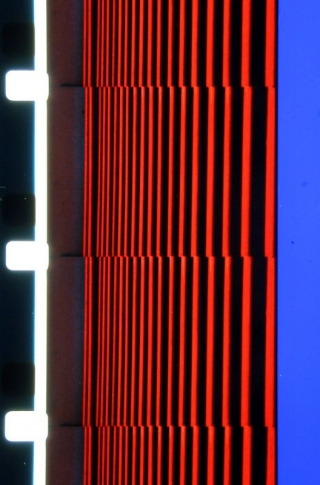Date: 25 October 2007 | Season: London Film Festival 2007 | Tags: London Film Festival
THE TIMES BFI 51st LONDON FILM FESTIVAL
Thursday 25 – Sunday 28 October 2007
London BFI Southbank
The Festival’s annual celebration of artists’ film and video returns on 27-28 October 2007 with an international programme of diverse and inventive work. For the first time, Experimenta will also occupy BFI Southbank’s new Studio over the weekend to present continuous installations of digital videos by Ken Jacobs and Rachel Reupke.
This year’s programme ranges from poetic journeys to unfamiliar locations to works which question aspects of specific histories. Whilst video remains the most accessible medium for independent artists, many are choosing again to work with film, either for its visual qualities or physical attributes. It’s ironic, or perhaps inevitable, that this revival of interest comes at a time when the future of celluloid seems to be constantly under threat. The selection includes several works in which artists have worked directly on the filmstrip to create striking and original imagery.
Carolee Schneemann did exactly that for her seminal film Fuses, made forty years ago and presented here in an astounding new preservation print. Marina Abramovic, another eminent and challenging artist, is featured in a hypotonic document of her Guggenheim Museum performance series.
Guest filmmaker David Gatten will lead a practical workshop on the use of text and the moving image, and we are pleased to welcome Peter Hutton to present his stunning new film At Sea.
Other artists featured in the weekend programme include Robert Beavers, Su Friedrich, Bruce Conner, Elodie Pong, Christoph Draeger, Jayne Parker, Steve Reinke, Emily Wardill, Michael Robinson, Mara Mattuschka, and Carl E. Brown. Many will be present appear to introduce and discuss their work over the two-day event. Many other artists will appear to introduce and discuss their work over the two-day event.
The ‘avant-garde weekend’ continues to be a unique occasion for London audiences to experience innovative new visions from around the world.
Other festival highlights for 2007 include the documentaries Black White + Gray: Portrait of Sam Wagstaff and Robert Mapplethorpe and A Walk Into The Sea: Danny Williams and the Warhol Factory (plus a programme of Danny Williams’ Factory Films), Guy Maddin’s Brand Upon the Brain!, and Casting A Glance, James Benning’s film of Robert Smithson’s Spiral Jetty.
Date: 25 October 2007 | Season: London Film Festival 2007 | Tags: London Film Festival
DAVID GATTEN: THE IMAGE & THE WORD (WORKSHOP)
Thursday 25 October 2007, from 10am-5pm
London BFI Southbank
Festival guest David Gatten leads a practical workshop on the use of text in 16mm filmmaking.
DAVID GATTEN: THE IMAGE & THE WORD (WORKSHOP)
Throughout the history of cinema, images and text have been combined on-screen in a variety of ways and for a range of reasons. Silent-era comedy, mid-century newsreels, avant-garde films and home movies have used words to tell stories, convey facts and explore the enjoyments and anxieties of reading. In this day-long workshop, Brooklyn artist David Gatten will provide an overview of such practice, with particular attention to filmmakers who have deployed on-screen text to investigate the way text functions as both image and language, the border between the legible and illegible, and the limits of what can be known through words.
David Gatten has made prominent use of the printed word in the ongoing series The Secret History of the Dividing Line (sections screened at the LFF in previous years) and his recent Film for Invisible Ink, Case No: 71: Base-Plus-Fog (showing in the Festival on 28 October 2007). Following introductory screenings of relevant works, participants will make their own films using a variety of processes, including direct-on-film applications, ink-and-cellophane tape transfers, slide projections, close-up cinematography, in-camera contact printing and more.
The workshop is suitable for both beginners and experienced practitioners.
Presented in association with no.w.here.
Back to top
Date: 27 October 2007 | Season: London Film Festival 2007 | Tags: London Film Festival
CAPITALISM: CHILD LABOR
Saturday 27 October 2007, from 12-7pm
London BFI Southbank Studio
Ken Jacobs, Capitalism: Child Labor, USA, 2006, 14 min (continuous loop)
Ken Jacobs continues his interrogation of archival sources by deconstructing a single stereoscopic photograph from the Victorian era. The image of barefoot children in a textile mill is spun into a critique of capitalism and the workforce of child labour which sustained the industrial revolution. With a dizzying array of visual techniques, space is condensed, expanded, flipped and cropped, accompanied by Rick Reed’s compelling soundtrack.
Ken Jacobs lives and works in New York City. Widely regarded as one of the key figures of independent and avant-garde cinema through films such as Little Stabs at Happiness (1958-60), Blonde Cobra (1959-63) and Tom Tom the Pipers Son (1969-71), Jacobs has also devoted much of his creative life to developing new techniques of live performance using film and projected light. More recently, and now in his seventies, he has become one of the most innovative and consistently productive artists working in digital video. Ken Jacobs has been featured in retrospectives, exhibitions and screenings at most major museums, biennials, film festivals and cinematheques.
PROGRAMME NOTES
CAPITALISM: CHILD LABOR
Saturday 27 October 2007, from 12-7pm
London BFI Southbank Studio
CAPITALISM: CHILD LABOR
Ken Jacobs, USA, 2006, video, colour, sound, 14 min
A stereograph celebrating factory production of thread. Many bobbins of thread coil in a great sky-lit factory space, the many machines manned by a handful of people. Manned? Some are children. I activate the double-photograph, composer Rick Reed suggests the machine din. Your heart bleeding for the kids? The children will surely be rescued and by their bosses! ‘Boys,’ they will say, ‘Have we got a war for you.’ (Ken Jacobs)
Capitalism: Child Labor is another masterful manipulation of old imagery. Ken Jacobs reworks a pair of stereoscopic photographs of barefoot children in a textile factory. The sepia-tone shots were originally taken with side-by-side cameras separated by the short distance between our two eyes. When placed in stereoscopic viewer, with the right eye seeing the right-hand image and the left eye seeing the left-hand image, you get a three-dimensional effect of depth. Jacobs begins his 14-minute video with tiny, twitchy pans across the two stereoscope photos. The highly repetitive imagery matches the highly repetitive tasks of the child workers frozen in time. Then Jacobs deconstructs the scene into overlapping insets and close-ups. Jacobs extracts a Cubist kaleidoscope from a vintage image. As for the critique of capitalism implied in his title, that’s for the viewer to extract. (Bill Stamets, Chicago Sun Times)
Back to top
Date: 27 October 2007 | Season: London Film Festival 2007 | Tags: London Film Festival
THE ‘I’ AND THE ‘WE’
Saturday 27 October 2007, at 2pm
London BFI Southbank NFT3
Su Friedrich, Seeing Red, USA, 2005, 27 min
A video confessional in which the artist expresses her frustration with the onset of middle age, frankly declaring personal anxieties. Interspersed with observational vignettes edited to Bach’s Goldberg Variations (played by Glenn Gould), Seeing Red is ultimately less an admission of crisis than a roar of defiance.
Elodie Pong, Je Suis Une Bombe, Switzerland, 2006, 7 min
Unprecedented and absolute: The image of a young woman ‘simultaneously strong and vulnerable, a potential powder keg.’
Jay Rosenblatt, I Just Wanted to Be Somebody, USA, 2006, 10 min
American pop singer Anita Bryant, the face of Florida orange juice, led a political crusade against the ‘evil forces’ of homosexuality in the 1970s. Local success was short lived, and a national boycott of Florida oranges was the first sign of her loss of public approval.
Steve Reinke, Regarding the Pain of Susan Sontag (Notes on Camp), Canada, 2006, 4 min
A journey from schoolyard to graveyard, with author Susan Sontag as philosophical guide.
Mara Mattuschka & Chris Haring, Part Time Heroes, Austria, 2007, 33 min
Mattuschka’s second adaptation of a piece by Vienna’s ingenious Liquid Loft (following Legal Errorist in 2004) exposes a trio of fractured characters. In the lonely hearts hotel of an unfamiliar zone, the amorphous heroes erratically construct and reveal their unconventional personas
PROGRAMME NOTES
THE ‘I’ AND THE ‘WE’
Saturday 27 October 2007, at 2pm
London BFI Southbank NFT3
SEEING RED
Su Friedrich, USA, 2005, video, colour, sound, 27 min
Su Friedrich created her latest experimental documentary, the half-hour Seeing Red, from just three elements: video diaries, shot from the chin down, in which she wears a red top; seemingly aleatory footage, often taken on the sly, of red things found on streets, in parks, or in backyards; and snatches of Glenn Gould’s rendition of Bach’s ‘Goldberg Variations’. At times, red bits of the world dance ecstatically to Gould’s cascading keys. Alone, to her camera, Friedrich confesses a string of related fears: Having turned 50, she faces the stubborn constancy of her self-identified ‘control freak’ patterns and insecurities and wonders if she still has time to change for the better. Friedrich is one of the most accomplished avant-garde filmmakers of her generation, with a career of films and videos whose masterful construction and precise beauty attest to the positive aspects of her self-criticism, and her stature only makes the humbling existential crises in Seeing Red more poignant. Yet she has always found ways to create beauty that resist the illusion of transcendence by sticking close to the grounds of hard reality – an influence and logical extension of her feminist politics. (Ed Halter, Village Voice)
www.sufriedrich.com
JE SUIS UNE BOMBE
Elodie Pong, Switzerland, 2006, video, colour, sound, 7 min
In her video Je suis une bombe, which is part of the ‘Supernova’ cycle, Elodie Pong presents a young woman wearing a panda bear costume who dances and writhes around a pole, in the manner of striptease performers. At the end of the performance, the young woman takes off her panda head and, holding it in her hand, moves towards the camera. Repeatedly and with a sense of urgency, she says ‘Je suis une bombe’, as if she needed to convince herself of her own peculiarity. In her videos Pong paints a kaleidoscopic picture of her own generation which she has pegged as narcissistic, searching, and performance-oriented. She remains a bit aloof, but never severs the ties with her protagonists – she knows, after all, that she herself is deeply involved. The body becomes the carrier of communication. This is not surprising as it is mainly the body which shapes our identity today. Pong tries to capture the reality of a generation by juxtaposing the subjective and the objective, as well as the real and the illusionary. The artist runs the entire gamut of contemporary emotions, and underneath some innocuous looking surfaces she discovers the depths of a silent world drowned out by ambient noise. (Kunsthaus Baselland)
I JUST WANTED TO BE SOMEBODY
Jay Rosenblatt, USA, 2006, video, colour, sound, 10 min
‘I believe, more than ever before, that there are evil forces round about us. Maybe even disguised as something good.’ These are the ironic words of the former beauty queen Anita Bryant, who became the face of homophobia in the United States in the 1970s. In I Just Wanted to Be Somebody, director Jay Rosenblatt sketches a portrait as funny as it is serious of the woman who unleashed the first public controversy over civil rights for homosexuals in 1977 by leading a successful local campaign against them. ‘In Florida, you won the battle, but lost the war. You gave a face to fear and ignorance’ was the response that Fenton Johnson, a gay American writer, wrote in a letter to her as an invitation to keep the debate alive. Rosenblatt creates comic effects by combining the public appearances in which Bryant warns against gay love with commercials that have her singing the praises of orange juice and vitamin C. But in no way does this make the danger of fear and ignorance any less recognisable. I Just Wanted to Be Somebody takes a stand for the importance of a discussion that Bryant is no longer willing to participate in. She lost her career and her family, but not her convictions. (International Documentary Film Festival Amsterdam)
www.jayrosenblattfilms.com
REGARDING THE PAIN OF SUSAN SONTAG (NOTES ON CAMP)
Steve Reinke, Canada, 2006, video, colour, sound, 4 min
This short video gets its name from two pieces of writing by Susan Sontag: her last book, Regarding the Pain of Others, a meditation on empathy and the photograph as document; and the highly influential essay, now close to fifty years old, Notes on Camp. Sontag’s work often questions photography’s ability to elicit empathy within the viewer. She analyzes whether personal topics, such as gender and disease, can be addressed given the vast dissemination of photographic images. Outed in the invite as a rehabilitation of the ‘tired indexicality of photograph’, Regarding the Pain of Susan Sontag (Notes on Camp), shows images that evoke a contemporary emotional ground zero, combined with Reinke’s pithy voice-over narration. (LUX)
www.myrectumisnotagrave.com
PART TIME HEROES
Mara Mattuschka, Chris Haring, Austria, 2007, video, colour, sound, 33 min
The search for fame’s elevator goes up and down, the ego’s bust and boom. Each character is isolated in his or her anachronistic, film-star dressing room, left alone, subjected to the sinister fittings: a hopelessly out-dated microphone, radio, crutches for communication. Each character gets a small chance to show that he or she alone is better at embodying that self, which is just as good as every other self. However, as though it were an uncanny copy machine of star production, the golden room, which houses the greatest striptease talent – since she constantly undress yet is never naked – generates a momentary double. The film checks these beings, isolated through their hero competition, into the lonely heart hotel where they eavesdrop on one another through thin walls, often over a film cut. Frivolous encounters slip in. A helplessly obscene seduction attempt mutates to telephone terror, confirmed by the humorous play of the eyes from the other side. From out of the elevator, an elevator technician – a show master, so to speak, a running gag, a lascivious ‘cursor’ in a boiler suit – creeps down the hallways. He alone seems to connect everything, but finds no one. Until the final take, a generous long shot in which all three heroes are left to their own showcases, whereby they attempt all together, each alone, to seduce their audience. Yet unimpressed passers-by give our heroes the cold shoulder, making the camera on the other side of the street their only audience. The Oseifabrik, furnished with technology from days gone by, lends eccentric historicity to one of the programmatic statements: ‘How do I become timeless?’ that releases this outcry for fame in a hopeless but unique vitality. (Katherina Zakravsky)
Back to top
Date: 27 October 2007 | Season: London Film Festival 2007 | Tags: London Film Festival
PAST IMPERFECT
Saturday 27 October 2007, at 4pm
London BFI Southbank NFT3
Christina Battle, Hysteria, Canada, 2006, 4 min
Through the manipulation of drawings of the Salem witch trials, using techniques which include peeling layers of emulsion from the filmstrip, oblique parallels are drawn with modern day hysteria.
Soon-Mi Yoo, Dangerous Supplement, USA-Korea, 2006, 14 min
‘Is it possible to see the landscape of the past even though it was first seen by the other’s murderous gaze?’ Dangerous Supplement poetically appropriates footage shot by US military to explore the secrets of the mountain, and the legacy of the Korean War.
Jayne Parker, Catalogue of Birds: Book 3, UK, 2006, 16 min
Following World War II, Messiaen’s fascination with birdsong inspired many compositions, and dominates the monumental ‘Catalogue d’Oiseaux’ of 1959. Jayne Parker has created a visual interpretation of the third movement – The Tawny Owl and The Woodlark – which evokes the habitat and symbolism of these nocturnal birds.
Bruce Conner, His Eye on the Sparrow, USA, 2006, 4 min
The power of music transports the founders of the Soul Stirrers gospel quartet back in time to the Depression Era. A poignant refrain by a master of found footage.
David Dempewolf, Marguerite Duras / Alan Resnais (0.65, 0.85, 1.0 FPS), USA, 2007, 19 min
The opening act of Hiroshima, Mon Amor has been condensed and structured, with urgent repetition, to reconstitute the dialogue between Duras’ text and Resnais’ vision. Words assume priority as potent images are crudely masked, emphasising details and inviting fresh analysis of this powerful sequence.
Christoph Draeger, Helenés (Apparition of Freedom), Switzerland, 2005, 18 min
Helenés combines two examples of propaganda from East and West. A bleak Hungarian instructional film on nuclear attack is presented in its entirely, strategically subtitled with text from George Bush’s inauguration speech (an idiosyncratic interpretation of the concept of freedom).
PROGRAMME NOTES
PAST IMPERFECT
Saturday 27 October 2007, at 4pm
London BFI Southbank NFT3
HYSTERIA
Christina Battle, Canada, 2006, 35mm, colour, sound, 4 min
Like nostalgia (april 2001 to present), this film is made up entirely of drawings. They show a house from the past century, the cartoonish figure of a man, a woman’s uplifted face praying, and then another. They are lent movement through the act of hand processing, a hail of scratches and blemishes course through the picture, reminding us that we are watching a loop of emulsion unspool. The image turns briefly and occasionally from positive to negative, the likely result of ‘flashing’ the film in the development process, quickly exposing it to light ‘prematurely’. This technique emphasizes the dual nature of the chemical image. Typically negatives are printed to create a positive for viewing. By showing us both at the same time, the artist remarks upon the usually hidden ‘dual’ nature of the picture – and it is hardly a coincidence that these technical namings (negative versus positive) carry distinct moral implications. A Puritan woman points at another in a gesture of accusation while a crowd looks on, an arm points at a woman praying in front of a tribunal. Near the two-minute mark the cartoonish figure of a man returns, this time emulsion lifted, flickering and shaking in an agitated dance. Dark figures in distress slide through the frame, there is a hanging, and then the emulsion lift frenzy is over. The silhouette of a hanged woman stands clear, a reminder of witch hunts past and present, the easy seduction of surfaces, and the migrations of names to these surfaces. Kike, polack, fairy, nigger, witch. (Mike Hoolboom)
DANGEROUS SUPPLEMENT
Soon-Mi Yoo, USA-Korea, 2006, video, colour, sound, 14 min
Most of the archival footage in Dangerous Supplement comes from US military footage under the titles Supplement to ‘This is Korea’, Korea Gun Camera and Native Life, shot during the Korean War. Dangerous Supplement originated from these questions: Is it possible to see the landscape of the past even though it was first seen by the other’s murderous gaze? Did the mountains and waters manage to escape it? Is there a space in-between? Dangerous Supplement is an incomplete index for memory, a substitute for a vision that is yet to exist. (Soon-Mi Yoo)
CATALOGUE OF BIRDS: BOOK 3
Jayne Parker, UK, 2006, video, b/w, sound, 16 min
Catalogue of Birds: Book 3, ‘The tawny owl and the woodlark’, is an interpretation of Olivier Messiaen’s music for piano, played by Katherina Wolpe. The imagery and music evoke the habitat and song of these nocturnal birds. Filmed in black and white, symbolic of the cycle of life and death, the owl is a harbinger of transformation, mediating between two worlds – the seen and unseen, the physical and spiritual. From the terror of night, the forest opens to grassland and we hear in the music, the transcendent song of the lark. (Jayne Parker)
HIS EYE ON THE SPARROW
Bruce Conner, USA, 2006, video, colour, sound, 4 min
Why should my heart be discouraged, why should the shadows come?
Why should my heart be lonely and long for heaven and home?
In the 1930s jubilee gospel singing underwent a metamorphosis when Roy Crain joined up with R.H. Harris and developed a new style of vocal arrangement with The Soul Stirrers. (Later members included Sam Cooke and Lou Rawls) The Soul Stirrers introduced a more complex kind of vocal presentation employing the innovations of falsetto and swing lead tradeoffs with guitar accompaniment and complex background singing with reiterated words or delayed echoing responses. Bruce Conner began working on By and By, a documentary about The Soul Stirrers several decades ago, shooting their reunion concert with four cameras and accumulating interview material. Conner was poised to finish the piece in the mid-1980s but the project was abandoned for a variety of financial and personal reasons. From the ashes of this project arises a new collage film miniature … thimble sized epiphany of conflicted history. In the past Conner created masterful pairings of sound and image with the music of Dylan, Ray Charles, Devo, Byrne and Eno, Respighi, Sibelius, Riley, Gleeson and others. His Eye on the Sparrow takes its name from a classic gospel song written by Lettuce Guest. The Soul Stirrers cut their version in Chicago on October 10, 1946, and it is this recording that is heard on the track. Carefree and complex the song moves in tandem with a set of found images that seem utterly transparent yet are evocative of other mysteries just out of reach. (Mark McElhatten)
MARGUERITE DURAS / ALAIN RESNAIS (0.65, 0.85, 1.0 FPS)
David Dempewolf, USA, 2007, video, b/w, sound, 19 min
Hiroshima mon amour (1959) is utilized as the central narrative that has been dissected into thematically ordered motifs. Marguerite Duras / Alain Resnais (0.65, 0.85, 1.0 fps) is set within the documentary opening of the film. The cinematic flow of the original has been drained and strung together in a series of still sequences. These sequences are determined by the frames per second export rates of 0.65, 0.85, and 1.0. The differences between frame rates in the video mean to invoke an awareness of the accumulation of synchronous and agonistic narratives over time, where the original historical event is a breech of interpretive models, and the temporal present is an unfixed state of intertextual stratifications. Each frame is marked with a number to track variations of the exported stills. The stills that correspond to the spoken dialogue are synchronous with the audio, and the stills that are without dialogue are shown for a single second. By isolating the enunciation of the script, Duras’ text as opposed to Resnais’ editing – becomes the temporal ordering format for the video. (David Dempewolf)
HELENÉS (APPARITION OF FREEDOM)
Christoph Draeger, Switzerland, 2005, video, colour, sound, 18 min
The Cold War was based on fear and deterrence. In both the East and the West, propaganda films were made to prepare people for the worst: a nuclear attack. Nowadays when we watch these films from the 1950s and 1960s, we are often struck by the naive clumsiness of the representation, usually culminating in the advice to take shelter under the stairs. However, some of these films were rather more realistic, as can be seen from the Hungarian 16mm film Helenés (‘Apparition’ in Hungarian) which Christoph Draeger used as an unaltered basis for his piece. Draeger found this film among a stack of 16mm rolls in a defunct disaster training camp of the Hungarian army in 1997. The editing, soundtrack and monotonous voiceover all bring to mind Alain Resnais’ masterpiece, the documentary Nuit et brouillard (1955). This was also impressionistic and remarkably silent, but incredibly threatening as a sad observation on the human condition. Unfortunately it applies to our times as well, possibly it is even a statement of all times. Draeger subtitled the voiceover of this film by using most of George Bush’s famous (or infamous) inauguration speech, in which, in anticipation of his military campaigns, he inflicted serious inflationary damage upon the concept of ‘freedom’ by repeating it no less than 41 times. (Netherlands Media Art Institute)
Back to top
Date: 27 October 2007 | Season: London Film Festival 2007 | Tags: London Film Festival
CAROLEE SCHNEEMANN PRESERVATIONS
Saturday 27 October 2007, at 7pm
London BFI Southbank NFT3
Newly preserved prints. Carolee Schneemann is a multi-media artist whose films, performances, installations and writings are a radical discourse on the body, sexuality and gender.
Carolee Schneemann, Fuses, USA, 1964-67, 29 min
Fuses is a vibrant celebration of a passionate relationship, openly portraying sexual intercourse without the objectification of pornography. To extend the tactile intimacy of lovemaking to filmmaking, Schneemann treated the filmstrips as a canvas, working by hand to paint, transform and cut the footage into a dense collage. The erotic energy of the body is transferred directly onto the film material. Recently preserved by Anthology Film Archives, this legendary work glows with a clarity unseen since its debut in the 1960s.
Carolee Schneemann, Kitch’s Last Meal, USA, 1973-76, c.60 min
The moving conclusion to the autobiographical trilogy which began with Fuses, Kitch’s Last Meal documents the routines of daily life. It was shot on the Super-8 home movie format and is projected double screen (one image above the other) as an interchangeable set of 18-minute reels. The soundtrack mixes personal reminiscences with ambient sounds of the household, and includes the original text used for Schneemann’s 1975 performance ‘Interior Scroll’. Time passes, a relationship winds down and death closes in: filming and recording stopped when the elderly cat Kitch, Schneemann’s closest companion for two decades, died. Each performance of the film in its original state was a re-ordering of the visual and aural materials, arranged by the artist according to mood and environment. For the preservation print, three pairs of reels have been selected and blown up to 16mm.
PROGRAMME NOTES
CAROLEE SCHNEEMANN PRESERVATIONS
Saturday 27 October 2007, at 7pm
London BFI Southbank NFT3
FUSES
Carolee Schneemann, USA, 1964-67, 16mm, colour, sound, 29 min
I wanted to see if the experience of what I saw would have any correspondence to what I felt – the intimacy of the lovemaking … And I wanted to put into that materiality of film the energies of the body, so that the film itself dissolves and recombines and is transparent and dense – as one feels during lovemaking … It is different from any pornographic work that you’ve ever seen – that’s why people are still looking at it! And there’s no objectification or fetishization of the woman. (Carolee Schneemann)
By interweaving and compounding images of sexual love with images of mundane joy (the sea, a cat, window-filtered light), she expresses sex without the self consciousness of a spectacle, without an idea of expressivity, in her words, ‘free in a process which liberates our intentions from our conceptions’. Carolee and her lover James Tenney emerge from nebulous clusters of colour and light and are seen in every manner of sexual embrace … one overall mosaic of flesh and textures and passionate embraces. Every element of the traditional stag film is here – fellatio, cunnilingus, close-ups of genitals and penetrations, sexual acrobatics – yet there’s none of the prurience and dispassion usually associated with them. There is only a fluid oceanic quality that merges the physical act with the metaphysical connotations, very Joycean and very erotic. (Gene Youngblood, Expanded Cinema)
Pornography is an anti-emotional medium, in content and intent, and its lack of emotion renders it wholly ineffective for women. This absence of sensuality is so contrary to female eroticism that pornography becomes, in fact, anti-sexual. Schneemann’s film, by contrast, is devastatingly erotic, transcending the surfaces of sex to communicate its true spirit, its meaning as an activity for herself and, quite accurately, women in general. Significantly, Schneemann conceives the film as shot through the eyes of her cat – the impassive observer whose view of human sexuality is free of voyeurism and ignorant of morality. In her attempt to reproduce the whole visual and tactile experience of lovemaking as a subjective phenomenon Schneemann spent some three years marking on the film, baking it in the oven, even hanging it out the window during rainstorms on the off chance it might be struck by lightning. Much as human beings carry the physical traces of their experiences, so this film testifies to what it has been through and communicates the spirit of its maker. The red heat baked into the emulsion suffuses the film, a concrete emblem of erotic power.’ (B. Ruby Rich, Chicago Art Institute)
The preservation of Fuses by Anthology Film Archives, New York, was supported by the University of Chicago Film Studies Center and the Andy Warhol Foundation for the Visual Arts.
KITCH’S LAST MEAL
Carolee Schneemann, USA, 1973-76, 2 x 16mm, colour, sound-on-cd, 3 x 20 min
In Kitch’s Last Meal synchronicity becomes a physical property, as with accident, as with joke – double entendre. The actual projection system is of two simultaneous Super 8 reels – vertical, one above the other. The disjunctive imagery has been intricately edited: two reels periodically phrase simultaneous images of the local freight train, which ran behind our house, as well as domestic events between the artist couple and the thematic constancy of the cat, Kitch, eating during the last four years of her life.
The film is composed of five hours of double co-ordinated reels; each set approximately twenty minutes long, so that various time units can be shown. The reels were edited over the five years of the filming. The sound was edited on cassette tapes.
The double vertical projection was intended to increase perceptual tension and its incremental satisfactions during the unexpected synchronisation of the horizontal entrance and exit of the train, of the figures moving in space, of the cat leaning to her dish. The verticality emphasises the axis of the body – its aspect of elongation in contrast to more predictable bilateral symmetry, the horizontal nature of stereoscopic vision. The repeated motions of the freight train situates a narrative physicalisation, corresponding with film itself moving through the mechanisation of the fixed track. Here the edge of the frame implies a leakage of time existing both before and after, just as the train enters our perceptual field seemingly from elsewhere (behind, moving forward to an invisible destination). At the conclusion of reels 11 & 12, I stand in the railroad tracks filming a train in diminishing perspective – as if time is actually being pulled away, as if the scale of an object can be reduced to a grain, a blur.
The visual parameters were determined by placing the camera close to positions occupied by the cat. The sound was recorded by suspending a microphone adjacent to the cat both indoors and outdoors. My premise was to film fragments of Kitch’s observations so long as she lived. I began this diary film on returning home to the Hudson Valley with the cat after dislocated years in Europe. Kitch, returning to her original house was already 16 years old. Since death and film seemed in a determined interchange, my intention was to film the cat in our domestic surround until she died.
Stan Brakhage always told me how mysteriously and consistently places he filmed were subsequently destroyed – houses disappeared, bridges were taken down; friends appearing in his films would soon move away, often without a trace. With Fuses, the celebration of an equitable and passionate relationship unexpectedly dissolved; Plumb Line became the imprints of a deforming love affair; Viet-Flakes observed fragments of brutality and disaster; while my small film portrait Carl Ruggles Christmas Breakfast captured the composer at 84 years old – the unintended poignancy of a simple meal. By 1973, the premise of Kitch’s Last Meal seemed to provide certain safety valves.
Our collusion was such that Kitch died almost 20 years old while eating a lamp chop. Kitch died on February 3rd. In March, the Walkill Valley Railroad announced that the small freight running behind the house from Albany to Walkill would be discontinued and the tracks dismantled. In May, my partner Anthony McCall decided we should separate and in June I was informed my teaching position would not be renewed. So much for my anticipated trade-off with film-death!
(Carolee Schneemann)
The 16mm blow-up and preservation of Kitch’s Last Meal by Anthology Film Archives, New York, was supported by the Andy Warhol Foundation for the Visual Arts.
Back to top
Date: 27 October 2007 | Season: London Film Festival 2007 | Tags: London Film Festival
MYSTERIOUS EMULSION
Saturday 27 October 2007, at 9pm
London BFI Southbank NFT3
Sandy Ding, Water Spell, USA, 2007, 42 min
A journey from realism to a supersensory realm, slipping under the surface and between molecules at a microscopic scale. Channeling the subconscious, Water Spell is both odyssey and invocation; a ritual of transformation and retinal blast. The film releases the energy locked within its frames through flickering pulsations of light.
Carl E. Brown, Blue Monet, Canada, 2006, 56 min (double screen)
Rarely shown in the UK, Carl Brown is a long-established film artist whose practice is dedicated to the modification of images by chemical means. Blue Monet is an homage to the French Impressionist, and an attempt to bring the Monet experience into the realm of cinema. Through the ebb and flow of intricate imagery, water lilies eternally blossom and fade with otherworldly grace. Brown has used his alchemical techniques to transfer Monet’s sense of colour, light, sky and water onto film. Viewed in spacious double-screen and enhanced by swathes of sound, this film is an immersive experience.
PROGRAMME NOTES
MYSTERIOUS EMULSION
Saturday 27 October 2007, at 9pm
London BFI Southbank NFT3
WATER SPELL
Sandy Ding, USA, 2007, 16mm, b/w & colour, sound, 42 min
Sandy Ding’s Water Spell is a bold, abstract journey that takes us into the psychic interior of our very cellular structure … and back. For me, this film is about reincarnation and transformation, on both the spiritual and sub-atomic levels. This is not an easy film, but it is a powerful one. (Nina Menkes)
BLUE MONET
Carl E. Brown, Canada, 2006, 2 x 16mm, colour, sound, 56 min (double screen)
This is an homage to Claude Monet and Eustace R. Brown who both taught me to ‘cultivate my garden’. In my film work over the past twenty years water has always been a touchstone for my emotional state. To look out at the water whether it be lake or sea is to face the two endless zones, that of water and sky and the mysterious edge at which they meet. I find this vision one of the strongest intimations of infinity. Monet is an artist that I have always greatly admired. His use of colour through water and sky to convey his emotional state has had a great influence on me. Whether it was the first rays of light glinting the water’s edge or the magic time just before nightfall, Monet’s sense of colour and colour conveyance has always been perfect. I have used my techniques of alchemical film to translate onto film my impressions of Monet’s sense of colour, water, sky and his most powerful icon the water lily. Using my toning, liquid emulsion, reticulation, dried crystal bleach formations and stacking techniques to just name a few I have translated the Monet experience onto the surface of my film. An illustrational form tells you through its intelligence immediately what the form is about, whereas a nonillustrational form works first upon sensation and then slowly leaks back into fact. Alchemical work provides both illustration and nonillustration simultaneously … the experiential depth of representation (the photographic source), and a sensuous (abstract) surface of the wild, both seen and unseen … but felt. That is what is art creation; a union between the beauty that is Monet converted through my alchemical nature into a new form for a new generation of viewers. (Carl E. Brown)
Back to top
Date: 28 October 2007 | Season: London Film Festival 2007 | Tags: London Film Festival
NOW WAIT FOR LAST YEAR
Sunday 28 October 2007, from 12-7pm
London BFI Southbank Studio
Rachel Reupke, Now Wait for Last Year, UK-China, 2007, 9 min (continuous loop)
In response to the rapid pace of property development in Beijing, Reupke references the visual style of architectural practice and corporate videos to present a sequence of fixed views of urban landscapes. Buildings which share the characteristics of both traditional and futuristic design are displayed, but all is not what it seems. Digital images cannot be trusted: these could be plans for future structures or computer-aided fantasy.
Rachel Reupke lives and works in London. Recent exhibitions include Land of Cockaigne, Fabrica, Brighton; Beyond the Country, Lewis Glucksman Gallery, Cork; Vidéo et après, Pompidou Centre, Paris (solo screening) and 24 Hour Fresh Air, L’Espace Croisé, Roubaix.
Now Wait for Last Year was produced as part of the Arts Council England International Fellowships Programme with Gasworks. The title is borrowed from Philip K. Dick.
PROGRAMME NOTES
NOW WAIT FOR LAST YEAR
Sunday 28 October 2007, from 12-7pm
London BFI Southbank Studio
NOW WAIT FOR LAST YEAR
Rachel Reupke, UK-China, 2007, video, colour, sound, 9 min
This video work reflects Rachel Reupke’s long-standing fascination with science fiction and the inherent problem of visualising the future.
Beijing is in the throws of a construction boom, break-neck in speed. Building sites are hemmed in by developers’ hoardings, each displaying an architect’s visualisation of what is to come in ambitious, blurry-soft style. Thousands of these billboards intrude on the streets: the future of the city rendered as illustrated inserts into the reality of its present – just as Beijing’s tourist maps pre-empt the completion of these projects, in order to keep up with the relentless pace of change. This visual overlay of proposed onto existent gives the impression that time is being compressed, and that tomorrow might actually be running concurrently with today.
Now Wait for Last Year takes the idea of these developers’ hoardings as its starting point. In a hybrid of architect’s projection and corporate video, Beijing’s buildings are presented in single-shot fixed frames, both monumental and unreal. Photographic in nature, but with visible post-production, the idea is that these images resist being located in a specific time or place. The collage aesthetic coupled with the incongruous design of some of these structures prompts the question as to whether these buildings actually exist in present day Beijing, are plans for future developments, or are sheer fantasy.
Back to top
Date: 28 October 2007 | Season: London Film Festival 2007 | Tags: London Film Festival
OVER LAND AND SEA
Sunday 28 October 2007, at 2pm
London BFI Southbank NFT3
Patrick Beveridge, The Ivalo River Delta, UK, 2007, 17 min
Shot within the Arctic Circle in northern Lapland, the film documents the landscape and lively night sky of an icy wilderness. The Aurora Borealis and other extraordinary phenomena are captured through long exposures and stunning time-lapse photography.
Peter Hutton, At Sea, USA, 2007, 60 min
Peter Hutton has modestly spoken of his work as being ‘a little detour’ from the history of cinema but perhaps he is following a path that others have neglected, or are yet to discover. Typified by fixed shots of extended duration, his concentrated gaze builds a bridge between early cinema, landscape painting and still photography, evoking Lumière, Turner and Stieglitz. Hutton’s camera often records the subtle changes of light and atmospheric conditions of rural and urban locations, and has frequently been directed toward nautical themes. This new film is essentially about the birth, life and death of large merchant ships. Following the construction of the vessels in South Korea and the passage of a massive container ship across the North Atlantic, it ends with images of shipbreaking in Bangladesh. At Sea is a real tour-de-force, in which the weight and scale of its subject is conveyed by masterful cinematography over a series of breathtaking compositions.
Peter Hutton will present a screening of his early work at Tate Modern on Monday 29 October 2007.
PROGRAMME NOTES
OVER LAND AND SEA
Sunday 28 October 2007, at 2pm
London BFI Southbank NFT3
THE IVALO RIVER DELTA
Patrick Beveridge, UK, 2007, 16mm, colour, silent, 17 min
The title of this film refers to the landscape where it was shot – an open marshland in northernmost Finland. This terrain, which is covered in thick snow during the winter months, provided a surface for filming changes in nocturnal light that are in response to the movement and position of the moon, and the sporadic displays of the polar lights. Such a project inadvertently raises the problem of landscape film as a genre in its own right. However, the film also has elements of astronomical and atmospheric photography. In particular, some experiments using film cameras placed on rotating celestial mounts lead to the unpredicted outcome of both the earth and the sky staying in focus with prolonged exposure for each frame. The film has a number of tracking shots, assembled in the chronological order they were taken, that document the events of particular nights. In filming above the horizon the camera moved with the stars across the northern sky. Against this backdrop displays of the polar lights occurred on clear nights, of which, during the unusually warm winter of 2005, there were few. (Patrick Beveridge).
AT SEA
Peter Hutton, USA, 2007, 16mm, colour, silent, 60 min
Films by Peter Hutton appear more closely related to landscape painting and still photography than contemporary cinema. In their stately portrayal of urban and rural locations, they afford the viewer a rarefied and highly-focused mode of looking, a stillness seemingly at odds with everyday life. Over shots of extended duration, the world reveals itself before the camera, which often records only subtle changes of light and atmospheric conditions. Peter Hutton began making films in 1970 and has work in the collections of the Whitney Museum, Centre Georges Pompidou and the Austrian Film Museum. A former merchant seaman, he has been a professor of film at Bard College in the Hudson River Valley since 1985. (Mark Webber)
Put simply, the film tells the story (‘the birth, life and death’, in the director’s words) of a container ship – but there are no words to adequately describe the film’s awesome visual expedition. Hutton knows the sea. His experiences as a former merchant seaman have informed his filmmaking practice, known for its rigour and epic beauty. At Sea begins in South Korea with diminutive workers shipbuilding. The colossal vessel is revealed in de Chirico-worthy proportions, its magnitude surreal to the human eye. Off to sea, the splendour and intensity of the water – set against the vibrant colours of the containers – causes us to see the world anew. The film concludes in Bangladesh amidst shipbreakers as enthralled by Hutton’s camera as we are by his images. (Andréa Picard, Toronto International Film Festival)
Back to top
Date: 28 October 2007 | Season: London Film Festival 2007 | Tags: London Film Festival
THE PERCIPIENT IMAGE
Sunday 28 October 2007, at 4pm
London BFI Southbank NFT3
Charlotte Pryce, Discoveries on the Forest Floor 1-3, USA, 2007, 4 min
‘Three miniature, illuminated, hagiographic studies of plants observed and imagined, hand-processed and optically printed.’ (Charlotte Pryce)
Allen D. Glass II, The Sky Walks Me Home, USA-China, 2005, 24 min
A journey through China, visiting northern provinces, Inner Mongolia, Tibet and Beijing. The filmmaker travelled alone, photographing the landscape and inhabitants of this extraordinary region with a keen and compassionate eye.
Timoleon Wilkins, The Crossing, USA, 2007, 6 min
Crowns of light and subtle gradations of colour are refracted through extreme close-ups of natural phenomena. Moments of sentience, an elevation of consciousness.
Minyong Jang, The Breath, Korea, 2007, 10 min
‘A respiratory exchange between me and a bamboo forest.’ (Minyong Jang)
Robert Beavers, Pitcher of Colored Light, USA, 2007, 24 min
Following the completion of his 17-film cycle ‘My Hand Outstretched’, Beavers travelled to New England to photograph the solitude of his mother’s house. Employing a more intimate approach to filming, he created this tender portrait which contrasts a dark interior with the vibrancy of an abundant garden. As seasons pass, the camera searches through shadows, conveying the slowed pace of life in old age.
PROGRAMME NOTES
THE PERCIPIENT IMAGE
Sunday 28 October 2007, at 4pm
London BFI Southbank NFT3
DISCOVERIES ON THE FOREST FLOOR 1-3
Charlotte Pryce, USA, 2007, 16mm, colour, silent, 4 min
‘Three miniature, illuminated, hagiographic studies of plants observed and imagined, hand-processed and optically printed.’ (Charlotte Pryce)
THE SKY WALKS ME HOME
Allen D. Glass II, USA-China, 2005, 16mm, colour, silent, 24 min
Humankind in the unfamiliar landscape, composing itself rhythmically and even lovingly into poetry. Nature as mammal music. The Life Dance. Foreign smells. And silences that are, of course, their own music. (Dorothea Grossman)
THE CROSSING
Timoleon Wilkins, USA, 2007, 16mm, colour, silent, 6 min
This film was born on two lazy afternoons – a product of my child’s eye fascination with the (always black) magic of viewfinder perception vs end product (the film). At the time I was deeply affected by Cormac McCarthy’s novel The Crossing, the second in his ‘border trilogy’ coming-of-age sagas set during the last vestiges of the truly wild west (Mexico-US border region circa 1930-40). The central character of this eerily perfect novel is a beautiful and adept teenage idealist who journeys on horseback into Mexico with the goal of returning a captured wolf to its native land. McCarthy’s seamless alternation between adventurism and spiritual naturalism is my inspiration. The resulting images of my ‘crossing’ are abstract by varying degrees. I later edited the film during a period of the most intense depression and self-doubt I have ever experienced: The resulting film-rhythms are punctuated by retinal afterimage and the odd alternation between the soft/tentative and the harsh/concrete. There is a visual allusion to crossing a river, and so this may also be interpreted as a contemplation of death’s journey. In actuality, it is the most highly worked-over of all my films, a departure that seems to be an appropriate nod to middle age and the peeling away of old concerns – my own, belated ‘coming of age’ story. (Timoleon Wilkins)
THE BREATH
Minyong Jang, Korea, 2007, 16mm, colour, silent, 10 min
An immersion in a bamboo grove, displaying all of Jang’s characteristic technical skill and capacity for abstemious observation. The Breath is a process of tension and release. The camera alternately distills and frees its attentions, cycling from tautly-held focus to diffuse, verdant colour fields. It’s light-as-air, following the breeze to track and rack down stalks, up stems, through leaves – ultimately following the rhythm of the filmmaker’s own respiration, merging Jang’s vital nature with its photosynthetic object. (Jeremy Rigsby, Media City)
PITCHER OF COLORED LIGHT
Robert Beavers, USA, 2007, 16mm, colour, silent, 24 min
I have filmed my mother’s house and her garden. The shadows play an essential part in the mixture of loneliness and peace that exists here. The seasons move from the garden into the house, projecting rich diagonals in the early morning or late afternoon. Each shadow is a subtle balance of stillness and movement; it shows the vital instability of space. Its special quality opens a passage to the subjective; a voice within the film speaks to memory. The walls are screens through which I pass to the inhabited privacy. We experience a place through the perspective of where we came from and hear someone else’s voice through our own acoustic. The sense of place is never separate from the moment. (Robert Beavers)
Back to top
